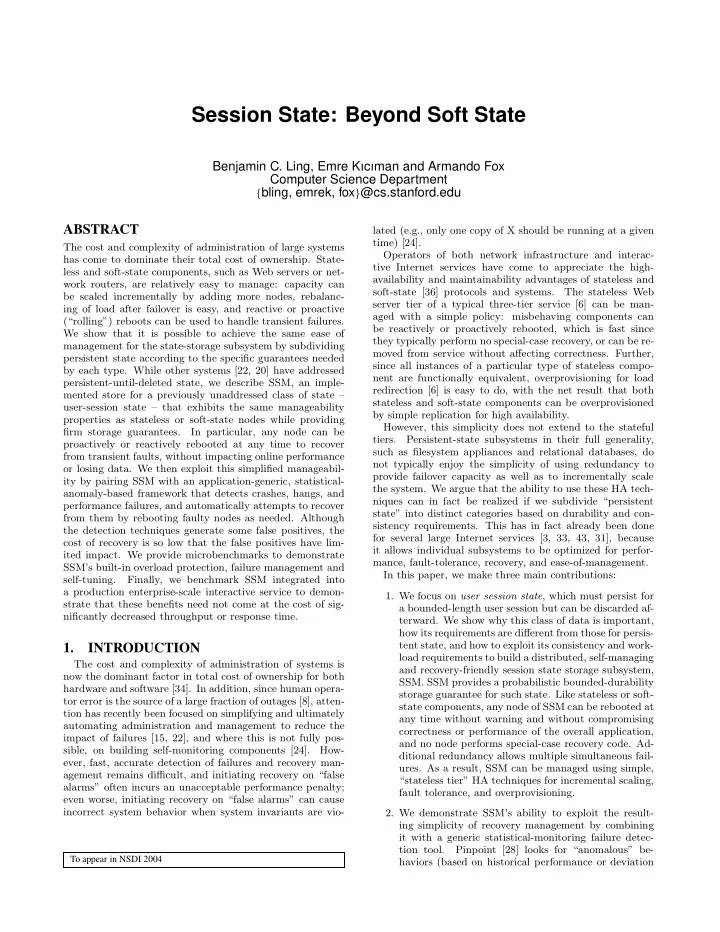

Session State: Beyond Soft State Benjamin C. Ling, Emre Kıcıman and Armando Fox Computer Science Department { bling, emrek, fox } @cs.stanford.edu ABSTRACT lated (e.g., only one copy of X should be running at a given time) [24]. The cost and complexity of administration of large systems Operators of both network infrastructure and interac- has come to dominate their total cost of ownership. State- tive Internet services have come to appreciate the high- less and soft-state components, such as Web servers or net- availability and maintainability advantages of stateless and work routers, are relatively easy to manage: capacity can soft-state [36] protocols and systems. The stateless Web be scaled incrementally by adding more nodes, rebalanc- server tier of a typical three-tier service [6] can be man- ing of load after failover is easy, and reactive or proactive aged with a simple policy: misbehaving components can (“rolling”) reboots can be used to handle transient failures. be reactively or proactively rebooted, which is fast since We show that it is possible to achieve the same ease of they typically perform no special-case recovery, or can be re- management for the state-storage subsystem by subdividing moved from service without affecting correctness. Further, persistent state according to the specific guarantees needed since all instances of a particular type of stateless compo- by each type. While other systems [22, 20] have addressed nent are functionally equivalent, overprovisioning for load persistent-until-deleted state, we describe SSM, an imple- redirection [6] is easy to do, with the net result that both mented store for a previously unaddressed class of state – stateless and soft-state components can be overprovisioned user-session state – that exhibits the same manageability by simple replication for high availability. properties as stateless or soft-state nodes while providing However, this simplicity does not extend to the stateful firm storage guarantees. In particular, any node can be tiers. Persistent-state subsystems in their full generality, proactively or reactively rebooted at any time to recover such as filesystem appliances and relational databases, do from transient faults, without impacting online performance not typically enjoy the simplicity of using redundancy to or losing data. We then exploit this simplified manageabil- provide failover capacity as well as to incrementally scale ity by pairing SSM with an application-generic, statistical- the system. We argue that the ability to use these HA tech- anomaly-based framework that detects crashes, hangs, and niques can in fact be realized if we subdivide “persistent performance failures, and automatically attempts to recover state” into distinct categories based on durability and con- from them by rebooting faulty nodes as needed. Although sistency requirements. This has in fact already been done the detection techniques generate some false positives, the for several large Internet services [3, 33, 43, 31], because cost of recovery is so low that the false positives have lim- it allows individual subsystems to be optimized for perfor- ited impact. We provide microbenchmarks to demonstrate mance, fault-tolerance, recovery, and ease-of-management. SSM’s built-in overload protection, failure management and In this paper, we make three main contributions: self-tuning. Finally, we benchmark SSM integrated into a production enterprise-scale interactive service to demon- 1. We focus on user session state , which must persist for strate that these benefits need not come at the cost of sig- a bounded-length user session but can be discarded af- nificantly decreased throughput or response time. terward. We show why this class of data is important, how its requirements are different from those for persis- tent state, and how to exploit its consistency and work- 1. INTRODUCTION load requirements to build a distributed, self-managing The cost and complexity of administration of systems is and recovery-friendly session state storage subsystem, now the dominant factor in total cost of ownership for both SSM. SSM provides a probabilistic bounded-durability hardware and software [34]. In addition, since human opera- storage guarantee for such state. Like stateless or soft- tor error is the source of a large fraction of outages [8], atten- state components, any node of SSM can be rebooted at tion has recently been focused on simplifying and ultimately any time without warning and without compromising automating administration and management to reduce the correctness or performance of the overall application, impact of failures [15, 22], and where this is not fully pos- and no node performs special-case recovery code. Ad- sible, on building self-monitoring components [24]. How- ditional redundancy allows multiple simultaneous fail- ever, fast, accurate detection of failures and recovery man- ures. As a result, SSM can be managed using simple, agement remains difficult, and initiating recovery on “false “stateless tier” HA techniques for incremental scaling, alarms” often incurs an unacceptable performance penalty; fault tolerance, and overprovisioning. even worse, initiating recovery on “false alarms” can cause incorrect system behavior when system invariants are vio- 2. We demonstrate SSM’s ability to exploit the result- ing simplicity of recovery management by combining it with a generic statistical-monitoring failure detec- tion tool. Pinpoint [28] looks for “anomalous” be- To appear in NSDI 2004 haviors (based on historical performance or deviation
Recommend
More recommend